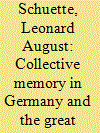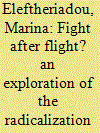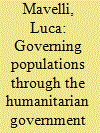| Srl | Item |
| 1 |
ID:
164358


|
|
|
|
|
| Summary/Abstract |
Embedded within the wider normalization–continuity debate about the nature of Germany’s actorness, this article assesses the impact of collective memory on German foreign policy during the European refugee crisis. The Federal Republic’s open-door policy in autumn 2015 bewildered many observers who saw it as a self-harming act of charity. Based on a three-stage empirical framework, the article argues that Germany’s initial behaviour cannot be understood without accounting for the influence that collective memory still exerts in Germany today. The open-door policy was irreconcilable with Germany’s immediate material interests, but instead shaped by collective memory-inspired humanitarian and European principles. This conclusion challenges the growing consensus among students of German foreign policy that Germany is becoming a normal actor which has freed itself from the constraints of the past and behaves in congruence with its material interests. This article seeks to make a timely contribution to the knowledge about collective memory in international relations, Germany’s foreign policy in the specific as well as wider context, and the dynamics of the European refugee crisis.
|
|
|
|
|
|
|
|
|
|
|
|
|
|
|
|
| 2 |
ID:
146020


|
|
|
|
|
| Summary/Abstract |
The European refugee crisis started in August 2015 and is regarded as the worst since World War II. It has had a serious impact on European society’s security and stability; and it has also revealed the vulnerabilities and problems with the EU common refugee policy.
|
|
|
|
|
|
|
|
|
|
|
|
|
|
|
|
| 3 |
ID:
173823


|
|
|
|
|
| Summary/Abstract |
Drawing on a survey of asylum seekers, the article provides a security assessment of the ‘refugee experience’ in Greece. This exploration of the ‘refugee situation’ on Europe’s eastern shore touches upon refugees’ prior and present grievances, the local and imported ‘radical milieu’ and (Greek) host state’s will and capacity to implement sustainable and effective policies. The paper demonstrates that, although Greece lacks a developed radical milieu that could facilitate radicalization, Greece’s policy of ‘uninvolved tolerance’ creates a vacuum that might be filled by radical groups in the future. Also, with the exception of minors’ education, Greece scores low in most socio-economic indicators that delineate the ‘refugee experience’. In this environment, scarce employment opportunities and dependence on external sources for life-sustainment interweave with institutionalization and negative coping mechanisms. These silent and largely hidden from the public eye processes might become the ingredients of future radicalization.
|
|
|
|
|
|
|
|
|
|
|
|
|
|
|
|
| 4 |
ID:
157605


|
|
|
|
|
| Summary/Abstract |
The notion of humanitarian government has been increasingly employed to describe the simultaneous and conflicting deployment of humanitarianism and security in the government of ‘precarious lives’ such as refugees. This article argues that humanitarian government should also be understood as the biopolitical government of host populations through the humanitarian government of refugees. In particular, it explores how the biopolitical governmentality of the UK decision to suspend search-and-rescue operations in the Mediterranean in 2014, and the British rejection and German welcoming of Syrian refugees primarily concern the biological and emotional care of the British and German populations. To this end, the article analyses how dynamics of inclusion/exclusion of refugees have been informed by a biopolitical racism that redraws the boundary between ‘valuable’ (to be included) and ‘not valuable’ (to be excluded) lives according to the refugees’ capacity to enhance the biological and emotional well-being of host populations. This discussion aims to contribute to three interrelated fields of research – namely, humanitarian government, biopolitical governmentality, and responses to the European refugee crisis – by exploring how biopolitics has shaped the British and German responses to the crisis and how it encompasses more meanings and rationalities than currently recognised by existing scholarship on humanitarian government.
|
|
|
|
|
|
|
|
|
|
|
|
|
|
|
|
| 5 |
ID:
182614


|
|
|
|
|
| Summary/Abstract |
The European refugee crisis has been communicated visually through images such as those of Alan Kurdi lying dead on the beach, by body bags on the harbor front of Lampedusa, by people walking through Europe and by border guards and fences. This article examines the broader visual environment within which EU policy-making took place from October 2013 to October 2015. It identifies ‘tragedy’ as the key term used by the EU to explain its actions and decisions and points out that discourses of humanitarianism and border control were both in place. The article provides a theoretical account of how humanitarianism and border control might be visualized by news photography. Adopting a multi-method design and analyzing a dataset of more than 1000 photos, the article presents a visual discourse analysis of five generic iconic motifs and a quantitative visual content analysis of shifts and continuity across four moments in time. The article connects these visual analyses to the policies and discourses of the EU holding that the ambiguity of the EU’s discourse was mirrored by the wider visual environment.
|
|
|
|
|
|
|
|
|
|
|
|
|
|
|
|